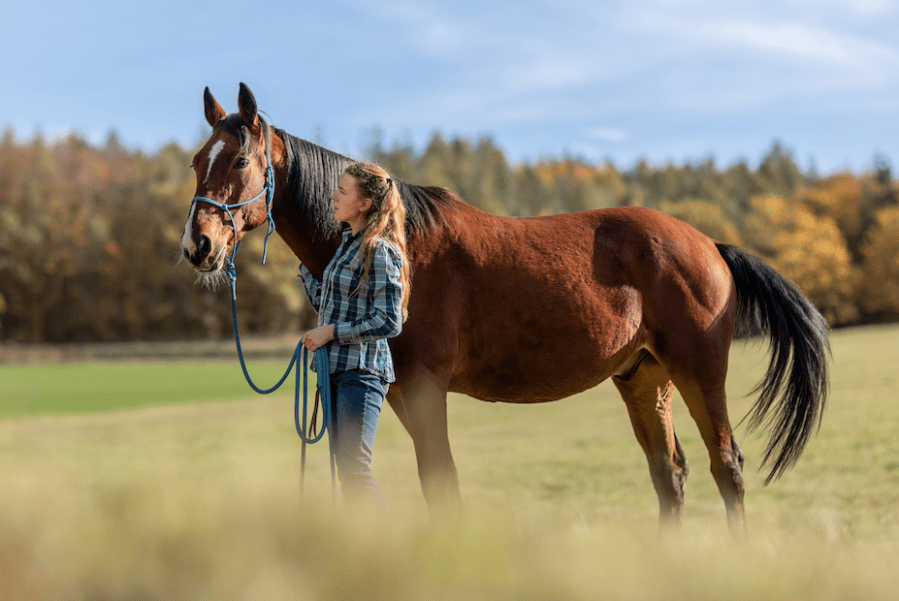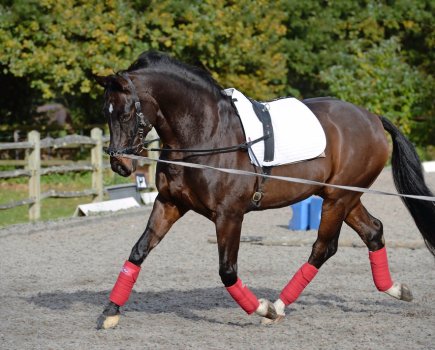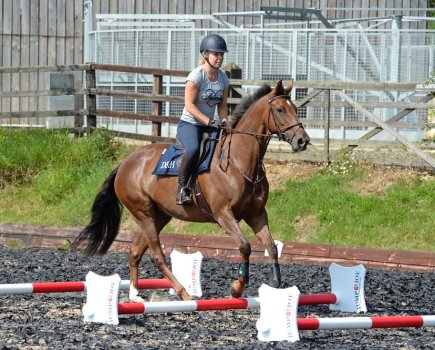If you are keen to incorporate some of the principles of natural horsemanship into your riding and training, or are simply interested to find out what this means, you’ve come to the right place. Fuelled by top names like Monty Roberts and Pat Parelli, many riders are keen to embrace all that natural horsemanship has to offer.
Whether you’re happiest hacking a horse, driving a carriage, or live for the thrill of competing in dressage and jumping, natural horsemanship is thought to hold the key to a more harmonious relationship with a horse as it helps you tap into their way of thinking.
Philosophy rather than science
Natural horsemanship is more of a philosophy than an exact science, based on the premise that in order to train horses effectively we need to tune into their natural instincts, body language and way of communicating within a herd, and understand that they learn not through fear or pain, but from pressure and the release of pressure.
Terms such as ‘horse whisperer’ give the impression natural horsemanship trainers come armed with a magic touch. In truth, they’ve simply learned, through years of experience of working with horses, what makes them tick.
Every natural horsemanship trainer has a slightly different take on what works and what doesn’t, but what unites them is the underlying principle that training should be humane as we empathise with our horses and learn to work with them, rather than against them.
Monty Robert’s Join-Up method
When Monty Roberts was a teenager in the early 1950s, he grew up studying the behaviour of the wild Mustangs he lived alongside in the USA. This led to the development of his world-famous Join-Up method as an alternative to the violence that was traditionally associated with the breaking-in process.
Join-Up creates a safe, co-operative environment in which a horse can progress and develop. It works on the premise that horses learn not through fear and intimidation, but through mutual respect and body language.
Working in a round pen, Join-Up starts with the natural horsemanship trainer making large movements and noise, as a predator would, driving the horse to run away.
They then adopt a more passive body language, turning their back on the horse with no eye contact. This invites the horse to come close and Join-Up, with them willingly choosing to be with the handler.
As Monty explains, his methods focus on communion with the horse, rather than domination. “For centuries, humans have said to horses, ‘You do what I tell you or I’ll hurt you’. I’m saying that no one has the right to say ‘you must’ to an animal or to another human,” he says.
Find out more about Monty and his Join-Up method
Parelli
With the emphasis on training people first and horses second, the Parelli concept was developed by husband and wife team Pat and Linda Parelli and quickly became a global phenomenon.
It is based on the principle of teaching people common sense around horses, so they can learn to negotiate effectively with their horse on the ground and in the saddle.
The Parelli philosophy focuses on building a horse’s confidence in five key areas:
- Self-confidence
- In you as their leader
- In themselves as a learner
- In new environments
- Among other horses
It does this via the Parelli Seven Games, which are the foundation of the Parelli natural horsemanship concept. The seven games of Parelli are:
- The Friendly game — This is about letting your horse become comfortable with you in their space.
- The Porcupine game — This teaches a horse to move away from a steady point of pressure (or feel).
- The Driving game — This is learning to move away from rhythmic pressure (ie light tapping) or the suggestion of pressure.
- The Yo-Yo game — Teaches your horse to back up, and then move forward when you retreat.
- The Circling game — Being able to ‘send’ your horse out on to a circle; letting the horse move forward on the circle with you in a ‘neutral’ position (this is the ‘allow’); then the ‘bring-back’, using the same body language as in the send to bring your horse back to you.
- The Sideways game — The horse learning to step sideways.
- The Squeeze game — Letting your horse become comfortable to ‘squeeze’ between objects.
Four levels of Parelli
Parelli focuses on four ‘Savvy’ levels to develop a person’s skills with horses both on the ground and in the saddle. The four ‘Savvys’ are:
- On line: communicating with the horse via lead rope
- Liberty: communicating with the horse on the ground without a lead rope
- Freestyle: riding without a constant rein contact
- Finesse: riding with a rein contact
Find out more about Parelli Natural Horsemanship
Michael Peace’s Think Equus
Horse training and behaviour consultant Michael Peace developed his Think Equus philosophy after working as an apprentice jockey.
He soon learned that understanding a horse’s mindset and developing a relationship based on mutual success made his working life easier. This led to his 50/50 approach.
In a nutshell, Michael’s premise is that a successful working relationship with your horse relies on a 50/50 partnership. You both have to do your bit for the benefit of the whole and. equally, the balance in the relationship is both of your responsibility.
You help each other out when necessary because you recognise the value of each other’s input. This means you never reach the level where you have to battle things out with your horse because you make tiny adjustments as you go along to keep everything in balance.
Find out more about Think Equus
Liberty horse training
The end goal of liberty horse training is for horse and handler to have established a true connection based on how horses interact with each other in a herd.
To work ‘at liberty’ means the horse is completely free to make their own choices and decisions: there are no saddles, bridles, head collars or lead ropes involved, even when being ridden.
Ben Atkinson is a master of liberty and he travels around the world giving demonstrations and talks about this method of natural horsemanship, alongside training stunt horses for film and TV.
“Liberty is exceptionally honest — it either works or it doesn’t, depending on the level of training,” says Ben.
“You can’t force the horse to do anything. Either your signals are clear and you and the horse understand each other, or you have proven that you don’t make good decisions often enough and the horse decides that you aren’t worth listening to.
“The aim is that, by the time you get to a point where you’re working with your horse loose, you have a confidence in that animal and that animal has confidence in you. The conversation flowing between both parties is so strong that you can achieve whatever you want,” adds Ben.
“The bond and love and mutual respect is something that is grown from communication. More than anything, liberty horse training is a system of communication.”
Find out more about Liberty Horse Training and Atkinson Action Horses
Kelly Marks’ Intelligent Horsemanship
Founded by Your Horse Live regular Kelly Marks, Intelligent Horsemanship is an organisation, its sole aim being to ‘bring the best horsemanship ideas together from around the world in an effort to promote understanding and fair treatment of horses’.
The daughter of a racehorse trainer, Kelly showjumped successfully in her teens before becoming a jockey. Intelligent Horsemanship was borne off the back of Kelly’s lifelong passion for horses.
It is heavily influenced by her friend and mentor Monty Roberts, whom she met through a chance meeting at a petrol station in France in 1993.
Kelly was trained by Monty and soon became the first teacher of his methods worldwide. Today, Kelly — together with a nationwide network of Recommended Associates — helps owners, on a practical level, to overcome behaviour problems and train their horses effectively.
On her website, Kelly is described as a ‘horse whisperer’ or ‘horse behaviourist’, specialising in understanding horse psychology, and finding workable solutions to benefit both horses and humans.
She helps people to ‘learn to understand your horse better and become the human a horse would choose’.
Find out more about Intelligent Horsemanship
Your Horsemanship
Developed in the UK by Australia-born Jason Webb, a regular contributor to Your Horse and Your Horse Live, Your Horsemanship embraces the philosophies passed down by generations of stockmen, who understood how to read a horse’s reactions to situations and adapt their own movements and behaviour to bring out the best in their equines.
Jason has spent years refining these techniques to develop a system based on three key areas:
- Developing a balance between trust and respect in both horse and rider in order to create the attitude to learn.
- Having the skills and confidence to to be a good leader to your horse.
- Understanding that knowledge is power.
The more you learn, Jason reasons, the more knowledge you can impart to your horse and the more your partnership will progress. Jason regularly tours the UK holding demonstrations, where you can watch him explain and show his natural horsemanship techniques.
He has a really lovely way of working with horses and riders — I know, because I’ve watched him work several times and I always leave inspired to try new things with my own horses.
If hacking a horse is your thing, Jason runs hacking confidence clinics, as well as offering general support and training, at this base in Kent.
Jason specialises in starting young horses and solving all ridden and behavioural problems, and he works with everyone, from leisure riders to Olympians.
Find out more about Your Horsemanship
Classical training
The world of natural horsemanship doesn’t stop at the five philosophies I’ve explained above. Its principles extend to the realms of the likes of classical dressage trainer Jenny Rolfe, who bases her training on the connection that simple breathing techniques can create.
Put simply, Jenny believes in connecting with horses via energy that’s created by her breath, which controls her heart rate. This, in turn, alters the energy surrounding her heart and changes the energy field around her, to which a horse will react.
“Horses are always listening to our signals, our voice, our body language and, most importantly, to our heart rhythms and energy field,” explains Jenny. “However, for much of the time they listen to signals when we’re not even aware we’re giving them.
“Scientific research has evidence from experiments with individuals that show that emotional distress causes chaos in the rhythm of the heart,” continues Jenny.
“Our horses quickly tune into our emotions and heart rhythm, and if the heart rhythm is steady they will immediately feel more calm. I am convinced that ‘breath energy’ is a natural part of herd language.”
Jenny adds that while horses respect assertive behaviour, aggression only creates anxiety. Her methods therefore involve learning to be more confident and the feel that it’s OK to expect your horse to listen to even the most subtle of clues.
“I teach my horse to listen to my breath when I’m riding. If he doesn’t respond to my breath, I take with my legs, just once.
“If he doesn’t respond to my legs, I’ll then tap my own leg with a whip. Because horses are so sensitive [remember they can feel a fly land on them] they can learn to respond to your breath in this way.”
Electromagnetic signals
The ‘energy’ Jenny speaks of is also referred to in science as electromagnetic signals. These waves are transmitted through space or matter by electric and magnetic fields, generated by a changing electrical charge.
In the human body, the heart has been proven to be the most powerful source of electromagnetic energy. This description might sound complicated, but using it doesn’t have to be.
“If there’s a spooky corner in your school, on your horse will react to, focus on your own state of relaxation. Sigh deeply and even yawn. Then try riding small circles towards the corner until they gradually take you closer to it. When you arrive at the spooky spot, relax your reins and sigh very deeply. As you relax, your horse will too,” says Jenny.
As well as how you use your breath, horses respond well to positive energy too.
“When you enter your horse’s stable, have you ever stopped to think what messages you’re giving?” asks Jenny. “Your horse will not only tune into your body language, but with your emotional state of mind and breathing too.”
When you’re feeling rushed and tense, your heart rate is faster. This state is known as heart incoherence.
“Approaching your horse in this states means you’ll have many thoughts rushing through your mind and less clarity of thought. In comparison, when you go into the stables with a clear mind, feeling calm, assertive and ready to enjoy the time you spend with your horse, you can gain the best response from them.”
Find out more about classical training with Jenny Rolfe
Horse whisperers
No guide to natural horsemanship is complete with including the ‘original’ horse whisperer, Buck Brannaman. Buck was the inspiration for the character of Tom Booker in the Nicholas Evans novel The Horse Whisperer, which went on to become a Hollywood blockbuster directed by and starring Robert Redford, alongside Scarlett Johansson and Kristin Scott Thomas.
Buck was one of the founders of the natural horsemanship movement. He developed his training methods based on the principles of patience, leadership, compassion and firmness. His goal is to help horses feel safe around people, so that horse and rider can achieve a true union.
Find out more about horse whisperer Buck Brannaman
Main image © Shutterstock









